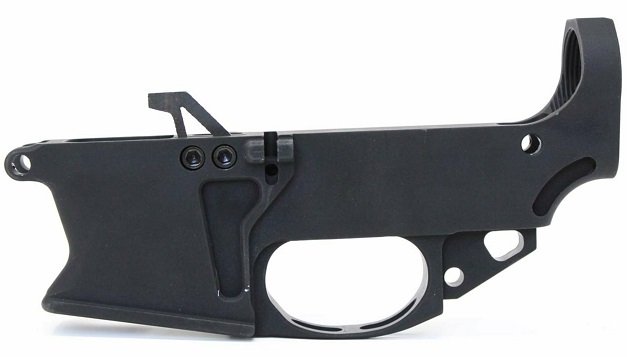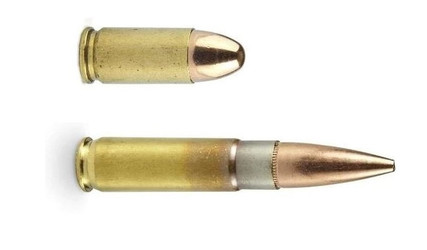.300 AAC Blackout vs. 9mm
Posted by Gun Builders Depot on Oct 20th 2021
They couldn't appear more different than one another: 300 Blackout, a centerfire rifle cartridge, and 9mm Parabellum, an old but proven handgun cartridge aren't so different after all. While the former is a round designed for the AR-15 platform, and while the latter was designed decades ago for service-issued handguns, 300 BLK and 9mm tend to go toe-to-toe when it comes to velocity, energy, accuracy, and general subsonic performance. Let's compared the two.
What is 300 Blackout?

The 300 Blackout was made by Advanced Armament Corp for a special operations military unit. The intent in developing this cartridge was to create a rifle round capable of both supersonic and subsonic flight, with ballistic performance similar to the 7.62x39mm found in the typical AK-47.
Today, the 300 BLK has become popular in the civilian shooting circuit, especially among short-barrel and suppressor owners. Those groups favor the round for its ability to be fired subsonic at close to medium ranges with a short barrel. The 300 Blackout enjoys popularity among AR-15 owners because it uses almost all standard 5.56/.223 parts. Only the barrel itself needs to be changed to swap from shooting 5.56/.223 to 300 Blackout. Receivers, bolts, lower parts, buffers, and gas systems are all interchangeable.
What is 9mm Parabellum?

The 9mm Parabellum (also called 9mm Luger or 9x19mm) is a handgun cartridge that was developed in 1902, in Germany. Originally chambered in the Luger pistol, the 9mm quickly earned favor among NATO countries, eventually becoming the handgun cartridge of choice among virtually every police, military, and counter-terrorism unit across the world.
The 9mm enjoys so much favor because of its compact size, manageable recoil, utter reliability, and impressive ballistics. Like 300 Blackout, the 9mm can be fired accurately at subsonic velocities, at close to medium ranges, with an incredibly short barrel.
So, at face value, these two cartridges look different, but they sound almost identical. What are the differences?
300 BLK and 9mm Ballistics

To accurately compare the performance of these two cartridges, we need to look at their ballistics when fired supersonic and subsonic. It's important to remember that barrel length affects velocity, and the data below is compiled using both cartridges' optimal barrel lengths for both loads.
For 300 Blackout, a 10.5" barrel provides excellent performance for all supersonic and subsonic loads. For 9mm, barrel length greatly affects velocity. If you want to reliably shoot subsonics below the supersonic threshold of 1,125 FPS, you need a barrel measuring just 4" to 5". A longer barrel - say, 9" - will make most loads leave the muzzle at supersonic speeds.
300 Blackout Supersonic
Federal American Eagle Suppressor
- Weight: 220 grains
- Muzzle Velocity: 990 FPS
- Muzzle Energy: 472 ft. lbs.
Hornady Sub-X Subsonic
- Weight: 190 grains
- Muzzle Velocity: 1,026 FPS
- Muzzle Energy: 443 ft. lbs.
Hornady Black Subsonic
- Weight: 208 grains
- Muzzle Velocity: 965 FPS
- Muzzle Energy: 468 ft. lbs.
300 Blackout Supersonic
Barnes OTM Supersonic
- Weight: 110 grains
- Muzzle Velocity: 2,173 FPS
- Muzzle Energy: 1,153 ft. lbs.
9mm Subsonic (4" Barrel)
Federal Hydra-Shok
- Weight: 147 grains
- Muzzle Velocity: 1,061 FPS
- Muzzle Energy: 331 ft. lbs.
Federal JHP
- Weight: 115 grains
- Muzzle Velocity: 1,094 FPS
- Muzzle Energy: 326 ft. lbs.
9mm Supersonic (9" Barrel)
Federal Hydra-Shok
- Weight: 147 grains
- Muzzle Velocity: 1,212 FPS
- Muzzle Energy: 365 ft. lbs.
Federal JHP
- Weight: 115 grains
- Muzzle Velocity: 1,180 FPS
- Muzzle Energy: 356 ft. lbs.
Key Takeaways
First, there's an important realization here: The 300 Blackout-chambered rifle or pistol can fire both supers and subs with one barrel length. But the 9mm platform must use a short barrel to maintain subsonic velocities, as we see above: Hydra-Shok and JHPs travel supersonic (faster than 1,100 FPS) with a 9" barrel. But they stay subsonic with a 4" barrel.
Second, we find that 300 Blackout's loads provide much heavier bullet weights and more energy in subsonic and supersonic loads. They're powerful than 9mm at close range and long ranges. Depending on your shooting requirements, you may desire that extra stopping power in exchange for a longer, heavier weapon with more recoil.
Third, we find 9mm tends to perform better well - achieving appropriate subsonic and supersonic velocities - with shorter barrels in either case. That means the 9mm-chambered AR will enjoy an overall shorter profile that's lighter, more compact, and more maneuverable.
Fourth, none of this means 9mm is better than 300 Blackout. The 300 BLK load can obtain greater ballistic coefficients thanks to its size, shape, and weight. That means when firing supersonic, you'll have much better accuracy at greater distance. We also see supersonic 300 BLK provides significantly greater stopping power than supersonic 9mm -- nearly four times the muzzle energy, in one case.
Which is better for an AR-15 Build?

So, we've come to the realization that you may want 300 Blackout because it allows you to reliably shoot supersonic and subsonic ammo reliably, using one modestly short barrel length. The 300 BLK also provides greater stopping power at longer distances than 9mm. But 9mm can provide you with a shorter, lighter gun, especially if you want to shoot 9mm subs.
Chances are, you want to put one of these two cartridges in a new AR-15 build. The AR platform has become hugely popular among 9mm and 300 BLK shooters for a few reasons. Both loads use the AR's original receivers and lower parts kits, as well as the same buffer tubes, handguards, and other bits.
In fact, the 300 Blackout AR uses exclusively 5.56/.223 parts, save for the barrel itself. The 9mm AR uses all original parts too, except for the magazine, barrel, buffer, and bolt carrier. The 9mm ditches the AR's gas system entirely, meaning no gas tube or gas block is required.
Direct Gas vs. Blowback Operation
How does 9mm work in the AR without a gas system? This cartridge is blowback-operated. That means the gasses expelled by the casing in the chamber drive the bolt backwards. No gas tube is required, and no gas key is installed on the 9mm bolt. Instead, the bolt face acts as a direct piston between the casing and bolt carrier.
The 300 Blackout cartridge still requires a gas system. The AR's gas block and tube work the same, in this case. Blackout uses a pistol-length tube to ensure subsonic loads cycle reliably.
Magazines and Receivers

The 300 BLK cartridge fits in the AR-15's original 5.56/.223 magazines, which is convenient. The 9mm cartridge uses GLOCK magazines for most AR builds. The 9mm lower receiver looks slightly different than the 5.56/.223 receiver, even though it uses a regular lower parts kit. That's because the magazine well is resized for 9mm magazines, and an ejector is required to be fitted to the lower, since one is not located on the bolt itself.
So, which cartridge should I pick?
If you want more stopping power at greater distances - and generally better accuracy - then 300 Blackout is the round to pick. With supersonic velocities, this rifle round is capable of providing suitable accuracy up to 400 meters downrange.
If you want to build a super-compact personal defense weapon that's light, produces low recoil, and yet is incredibly powerful, 9mm is the round to consider. It's arguably the most popular self-defense cartridge in the world. Combining its performance with the AR platform creates a truly effective weapon at close ranges and up to 150 to 200 meters.
FAQs
Q: Can I convert my existing AR-15 in 5.56/.223 to 300 BLK or 9mm?
A: Yes, a 5.56 or .223 AR-15 can be converted to shoot 300 Blackout or 9mm. Converting to 300 Blackout requires swapping barrels and installing a pistol-length gas system. Converting to 9mm requires swapping barrels and bolts, removing the gas system, and installing a magazine conversion block with built-in ejector, or swapping your 5.56 lower receiver for an AR-9 lower.
Q: Which cartridge is better for shooting only suppressed loads?
A: 300 Blackout is the better choice if you prefer the most power and distance possible. 9mm is the better choice if you prefer the quietest loads being fired from a more compact firearm. Shooters say 9mm is somewhat quiter than 300 Blackout when suppressed, since it burns less powder and produces less chamber pressure.
Q: What's the max effective range of both cartridges?
A: Even supersonic 9mm fails to compete with 300 Blackout when it comes to distance. Super 9's will provide acceptable accuracy out to 150 meters or so. These loads are simply too slow and too light to withstand bullet drop and wind drift at greater distances.
Supersonic 300 Blackout can provide acceptable accuracy at 400 meters or more with a 10.5" barrel. Some shooters have managed to accurately hit targets at 450 to 475 meters. This can be accomplished with a 12" barrel and ultra-light loads to maximize velocity and reduce bullet drop.
Q: Where can I learn more about the AR-9 and 300 Blackout AR-15?
A: We've written very detailed build and ballistic guides covering both ARs. You can read the 300 Blackout Guide here, and the AR9 Build and Ballistics Guide here.
DISCLAIMER: If you are new to the world of DIY gun building, you likely have a lot of questions and rightfully so. It’s an area that has a lot of questions that, without the correct answers, could have some serious implications. At GunBuilders.com, we are by no means providing this content on our website to serve as legal advice or legal counsel. We encourage each and every builder to perform their own research around their respective State laws as well as educating themselves on the Federal laws. When performing your own research, please be sure that you are getting your information from a reliable source.

